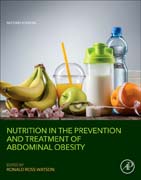
Nutrition in the Prevention and Treatment of Abdominal Obesity
Watson, Ronald Ross
Nutrition in the Prevention and Treatment of Abdominal Obesity, Second Edition focuses on the important role that exercise, dietary changes and foods play in promoting and reducing visceral fat. Nutritionists, dieticians and healthcare providers seeking to address the abdominal obesity epidemic will find this book to be a valuable resource in their long-term goal of preventing chronic diseases, especially heart, vascular and diabetic diseases. Chapters define a range of dietary approaches to reduce risk for the associated chronic diseases. In addition, discussions of the importance of dietary approaches to reduce abdominal obesity, along with clinical approaches, are discussed, including costs and risks. Serves as a starting point for in-depth discussions in academic settings that will lead to revised and updated treatment options Offers detailed, well-documented reviews outlining the various dietary approaches to visceral obesity with their benefits and failuresIncludes updated research on the gut microbiome, FGF 21 and dietary foods and supplements INDICE: Section I. Overview of Obesity and Population Studies1. Sleep, Abdominal Obesity, and Metabolic Syndrome 2. The new anthropometrics and abdominal obesity: a body shape index, hip index, and anthropometric risk index3. Comparing measures of obesity: waist circumference, Waist-hip and waist-height ratios4. Abdominal Obesity and the Interaction between Adipocytes and Osteoblasts5. Pharmacologic Agents Chapter for Abdominal Obesity6. Sleeve Gastrectomy for Morbid Obesity: Technique and Outcomes7. Comparing Measures of Obesity: Waist Circumference, waist-hip and waist-height ratios8. Abdominal obesity in children: the role of physical activity, sedentary behavior and sleep time9. The concept of a web-based calculator for supporting waist circumference interpretation among pediatric patients10. Remission of metabolic syndrome after sleeve gastrectomy11. Nutrients and Obesity12. The role of physical activity in adult obesitySection II. Mechanisms of Obesity 13. Fibroblast growth factor 21 as a regulator of energy metabolism in the liver and adipose tissue14. Genetics of Central Obesity and Body Fat15. Stress-Induced Eating Dampens Physiological and Behavioral Stress Responses16. An emerging role of angiotensin receptor binding protein ATRAP as a possible novel player in pathophysiology of visceral obesity and metabolic disorders17. Ethnicity and Cut-Off Values in ObesitySection III. Role of Dietary Supplements in Obesity 18. Regulation of the Energy balance19. Using Psyllium to Prevent and Treat Obesity Comorbidities 20. Dairy Whey Proteins and Obesity Section IV. Foods and Macronutrients in Obesity21. The Mediterranean diet: what it is and its effect on abdominal obesity22. International aspects: Abdominal obesity in Greece 23. Artificial sweeteners: implications for weight loss in obesity 24. Coffee Intake and ObesitySection V. Micronutrients and Dietary Components in Obesity 25. Conjugated linoleic acid in human health: Effects on weight control26. Serum magnesium and abdominal obesity and its consequences27. Integrative Health and Medicine: Dietary supplements and modalities for the treatment of obesity28. Anthocyanins: What They Are and How They Relate to Obesity Prevention29. The Positive Effects of Olive Oil Towards Lipotoxicity and Obesity30. Effects of diet-induced early-stage obesity on a low-testosterone Gottingen minipig31. The Effects of Fiber on Visceral Fat32. Carotenoids as Nutraceutical Therapy for Visceral Obesity33. Laparoscopic Adjustable Gastric Banding (LAGB) as a Bariatric Procedure
- ISBN: 978-0-12-816093-0
- Editorial: Academic Press
- Encuadernacion: Rústica
- Páginas: 522
- Fecha Publicación: 06/12/2018
- Nº Volúmenes: 1
- Idioma: Inglés
